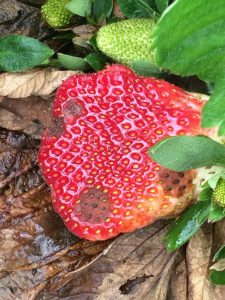We confirmed anthracnose on strawberry fruit a couple of days ago in a northern Georgia location. The recent warm, moist conditions have been obviously acceptable for anthracnose development, and with rain splash, anthracnose can rapidly infect strawberries throughout a planting. Though it has been dry in some parts of the state, I would still scout for anthracnose on the berries. If it is present, these berries should be removed from the field and destroyed. Though most berries will be of no consequence relative production at this time, the infected berries will serve as a source of inoculum this spring. If anthracnose is confirmed now, I would recommend more captan applications prior to bloom to suppress the pathogen, especially if warm conditions continue. If cold, anthracnose will not infect. Once blooms start, I would recommend a high risk anthracnose management program (if anthracnose is currently confirmed). Recommendations for anthracnose management can be found in the strawberry IPM guide at www.smallfruits.org. Maintain a vigilant spray program while also scouting for infected berries this year.

If you are observing anthracnose on strawberry at any time this year, there are a couple of things you can do that would be helpful relative this crop and future crops. For both of these items, the information or samples would go to Dr. Natalia Peres in Florida. She is determining whether the plant source is important to anthracnose issues (e.g. coming in with nursery plants) and/or whether strobilurin fungicide (Abound, Pristine, etc.) resistance is an issue.
Two things: (1) find out the source of the plants and (2) send diseased strawberries (individually sealed in ziplock bags and packed appropriately for travel) to Natalia in Florida. Please provide a note with the cultivar, nursery source (very important), and what fungicides were sprayed during the last month. For strawberry anthracnose samples, it would be best to wrap individual symptomatic strawberries in dry paper towels that are then placed in individual plastic bags (ziplock sandwich bags or something of that nature). This will keep individual berries from rotting together, while also keeping the fungal samples from mixing – possibly giving a false reading. Try to collect as many as 10 berries. Overnight shipping is preferred, as the berries are less likely to break down prior to delivery. Your local county agent has been provided with a Fedex number that will allow shipment to Dr. Peres at no cost to you, and they can help you with coordinating this shipment. Prior to shipment, it would be good to communicate with Natalia to let her know to expect a sample.
Here is her mailing address and contact information:
Natalia A. Peres
University of Florida, GCREC
14625 County Road 672
Wimauma, FL 33598
(813) 633-4133